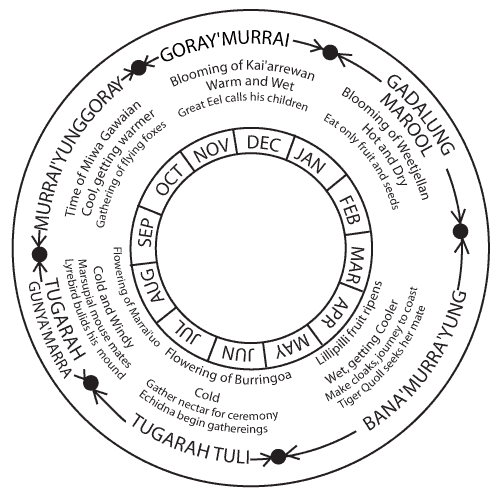Indigenous Weather Patterns for Sydney
Understanding the seasonal patterns of the place we inhabit is essential. Many have noted the recent ‘unseasonably’ warm weather, yet perhaps it’s our seasonal calendar that is out of sync, not the weather itself.
The Eora people of the D’harawal nation, traditional custodians of the land, have thrived within this landscape for over 50,000 years. Their profound understanding of the interconnected cycles of weather, flora, and fauna has led to the development of a detailed weather calendar based on the behavior of plants and animals, featuring six distinct seasons:
January to March: Gadalung Marool—hot and dry
In this season, male kangaroos get aggressive, signaling a ban on meat consumption due to spoilage risks and potential food poisoning from the heat. The blooming of Weetjellan (Acacia Implexa) warns against lighting fires near bushland, predicts violent storms and heavy rain, and advises against camping near water bodies.
Acacia Implexa
April to June: Bana’murrai’yung—wet becoming cooler
When Marrai’gang (Quoll) cries for a mate and Lilly Pillys ripen, it’s time. As Lilly Pillys fall, repair or make new warm cloaks and start the annual coastal migration.
Flowering Lilly Pilly
June to late July: Tugarah Tuli—cold, frosty, short days
Male Burrugin (echidnas) form lines to court females, while Burringoa (Eucalyptus tereticornis) blooms signal nectar collection for upcoming ceremonies. Shellfish consumption should pause until the Boo’kerrikin (Acacia decurrens) blooms.
Eucalyptus Tereticornis
August: Tugarah Gunya’marri—cold and windy
Lyrebirds build dancing mounds to attract mates as Marrai’uo (Acacia floribunda) flowers, indicating fish abundance in rivers. Boo’kerrikin (Acacia decurrens) blooming marks the transition from cold winds to gentle spring rains.
Acacia Floribunda
September to October: Murrai’yunggorry—cool, getting warmer
The gathering of flying foxes marks a ceremonial time for the D’harawals, featuring their sky-dancing display over Sydney at dusk before heading south to feed. It starts with the blooming of the bright red Miwa Gawaian (Telopea speciosissima).
Telopea Speciosissima
November to December: Goray’murrai—warm and wet
This season starts with eels migrating to the ocean to mate, signaled by the Great Eel Spirit and the blooming of Kai’arrewan (Acacia Binervia), indicating fish in bays and estuaries.
Acacia Binervia
Thus, the warm March we experienced aligns with the end of Gadalung Marool, the traditional hot and dry season. As weather patterns become increasingly erratic and extreme due to global warming, observing the signs of passing seasons as understood by the D’harawal becomes ever more crucial. There is invaluable wisdom to be gained from the traditional custodians of this land. Embracing and integrating their knowledge into our lives is essential for coexisting with the natural world.







